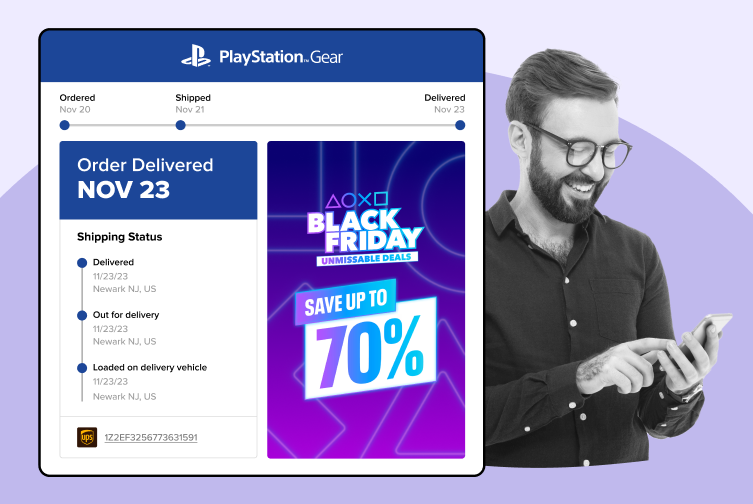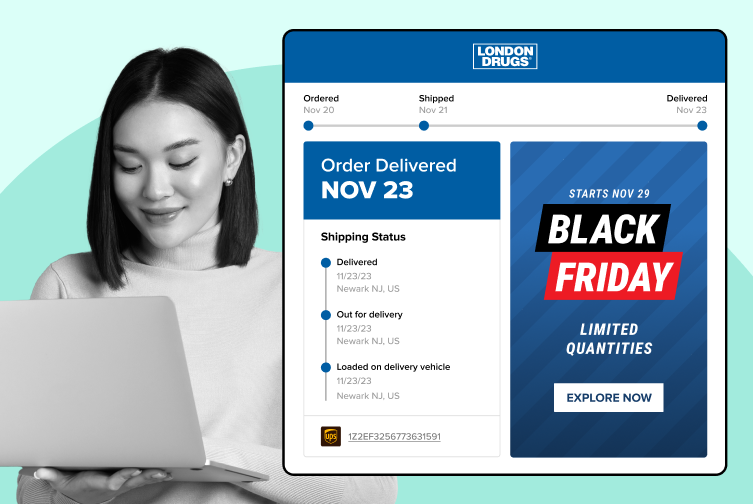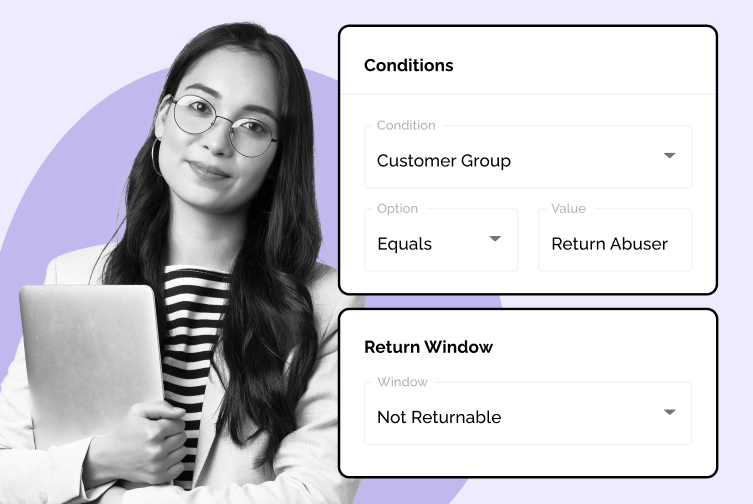
Effective Shipping Exceptions Handling and Keeping Customers Informed
Learn effective strategies for handling shipping exceptions and keeping customers informed. Enhance your shipping process today!
Shipping, Tracking & Notifications
Boost customer experience and reduce support tickets
Realtime order and shipment tracking
Proactive order and shipping notifications
AI-Enhanced Discounted Labels
Predictive pre-purchase estimated delivery dates
Self-Serivce branded order tracking
Effortless experience delivered
Identify and Resolve Order Issues
Realtime order and shipment tracking
Make returns profitable and delight customers
Flexibility to define any return destinations & conditions
Simplify returns for your customers and team
Incentivize exchanges over returns
Returns management made easy for your team
Returns management made easy for your team
Easy claims and smart upsells
Understand why your customers are returning
In-Store & Curbside Pickup
Unify the online and the in-store experience
Hassle-free pickup experience for customers
In-Store dashboard to keep operations streamlined
In-Store and Online orders unified
Drive foot-traffic to your stores
Shipping, Tracking & Notifications
Boost customer experience and reduce support tickets
Realtime order and shipment tracking
Proactive order and shipping notifications
AI-Enhanced Discounted Labels
Predictive pre-purchase estimated delivery dates
Self-Serivce branded order tracking
Effortless experience delivered
Identify and Resolve Order Issues
Realtime order and shipment tracking
Make returns profitable and delight customers
Flexibility to define any return destinations & conditions
Simplify returns for your customers and team
Incentivize exchanges over returns
Returns management made easy for your team
Returns management made easy for your team
Understand why your customers are returning
In-Store & Curbside Pickup
Unify the online and the in-store experience
Hassle-free pickup experience for customers
In-Store Dashboard to keep operations streamlined
In-Store and Online orders unified
Drive foot-traffic to your stores
Boost customer experience and reduce support tickets
Realtime order and shipment tracking
Proactive order and shipping notifications
AI-Enhanced Discounted Labels
Predictive pre-purchase estimated delivery dates
Self-Serivce branded order tracking
Effortless experience delivered
Make returns profitable and delight customers
Flexibility to define any return destinations & conditions
Simplify returns for your customers and team
Incentivize exchanges over returns
Returns management made easy for your team
Equip your team for precise return checks.
Easy claims and smart upsells
Understand why your customers are returning
Unify the online and the in-store experience
Hassle-free pickup experience for customers
In-Store Dashboard to keep operations streamlined
In-Store and Online orders unified
Drive foot-traffic to your stores
Find the answer to all your questions
Take a step by step trip through our functionality to see how we can improve your ecommerce processes.
Explore the most comon questions about WeSupply
Calculate the ROI that WeSupply can bring you
Read actionable articles on how to optimize your post-purchase experience and decrease support tickets
Get inspired by stories of how our customers implemented an effortless post-purchase experience
Wondering if WeSupply is a good fit for you? Read through our use cases to see how we can help you increase conversion & improve CX!
A Deep Dive into Top Companies' Order Tracking & Returns Strategy
Find the answer to all your questions
Explore the most comon questions about WeSupply
Calculate the ROI that WeSupply can bring you
Request a no strings attached review of your current shopping experience and missed conversion opportunities
Take a step by step trip through our functionality to see how we can improve your ecommerce processes.
Read actionable articles on how to optimize your post-purchase experience and decrease support tickets
Get inspired by stories of how our customers implemented an effortless post-purchase experience
A Deep Dive into Top Companies' Order Tracking & Returns Strategy
Wondering if WeSupply is a good fit for you? Read through our use cases to see how we can help you increase conversion & improve CX!

Returns are an unavoidable part of commerce, especially for enterprises operating at scale. Whether you run a global retail brand, a large marketplace, or a B2B operation, the way you handle returns can make or break customer trust. A poorly managed returns process frustrates customers, increases costs, and strains operations. A scalable returns management system solves these challenges by combining clear policies, automation, and data-driven processes.
This guide walks you through how to build an enterprise returns system that is efficient, customer-friendly, and scalable as your business grows.
Enterprise-level businesses face returns at higher volumes and complexity than smaller sellers. For example, Shopify reported that 20–30% of all online purchases are returned by retailers, compared to just 8–10% in brick-and-mortar retail. When that scale multiplies across thousands or millions of transactions, the operational and financial impact including high return costs becomes significant.
Without a system built for scalability, you risk:
Delayed refunds and exchanges
Rising customer service costs
Higher inventory losses
Lower repeat purchase rates
A scalable system transforms returns from a cost center into a customer retention strategy. Customers judge you less for the return itself and more for how seamless the experience feels, and whether the process meets customers expectations.
A successful enterprise returns management system is designed to build an effective returns management process through three core pillars: standardized policies, automation technology, and centralized visibility.
To achieve this, it is crucial to have access to the right tools and platforms that support each pillar. Let’s break these down.
Customers want to know what to expect. A confusing or hidden return policy increases dissatisfaction. Enterprises need policies that balance customer satisfaction with cost control.
Best practices include:
Publishing policies clearly on product pages and at checkout
Setting standard return windows (e.g., 30 days) with exceptions for certain product categories
Using conditional rules for items like final-sale goods or electronics
Offering flexible options like exchanges or store credit
Clearly stating any return fees in the policy to ensure transparency and manage costs
Policies should also define the return request process, outlining how customers can initiate a return and what steps are required for approval or disapproval. This helps set clear customer expectations and streamlines the return authorization process.
According to Narvar, 96% of consumers would shop with a retailer again if the return process was easy. Clarity pays off in loyalty.
Manually processing thousands of returns is unsustainable. Automation helps deliver efficient returns management by reducing errors, shortening refund timelines, and freeing customer support teams.
Examples of automation in returns management that save time and resources:
Self-service returns portals where customers initiate requests without contacting support
Automated label generation for shipping
Smart routing that directs returns to the nearest warehouse or resale partner
Instant eligibility checks for refund vs. exchange
WeSupply, for instance, provides enterprises with a branded self-service portal and automated routing rules that scale with order volumes.
Large enterprises often operate across multiple warehouses, carriers, and geographies. Without centralized visibility, it’s impossible to track return trends, enforce policies, or make data-driven improvements.
Centralized systems give your teams a single source of truth for all the information needed for decision-making, including:
Return status across all channels
Real-time updates for customers
Analytics on top return reasons
Cost per return and recovery rates
This visibility not only improves customer communication but also helps identify preventable return drivers like sizing issues or product defects, and supports better integration with inventory management systems.
Manual processing in returns management can quickly become a bottleneck for enterprises, especially as return volumes grow. Relying on manual tasks often leads to errors, delays, and inconsistent experiences, all of which can negatively impact customer satisfaction. Customers today expect a fast, seamless returns processanything less can erode trust and loyalty.
By implementing an efficient returns management system, businesses can automate key steps in the returns process, from handling return requests to processing refunds and exchanges. Automation not only reduces the risk of human error but also accelerates the entire process, helping to keep both your customers and your team happy. This streamlined approach can significantly lower shipping costs and operational expenses, directly improving profit margins.
Effective returns management capabilities are essential for businesses that want to stay competitive. By focusing on delivering efficient returns management, companies can process returns quickly, provide timely refunds, and offer smooth exchanges—all of which contribute to improved customer satisfaction. In today’s market, investing in a robust returns management system is not just about saving costs; it’s about meeting customer expectations and building long-term loyalty.
Start by analyzing your existing returns process. Identify pain points such as:
High manual workload on support staff
Long refund processing times
Lack of integration with carriers or inventory systems
Customer complaints about unclear policies
Challenges in inspecting and processing returned items, including evaluating their condition for restocking or disposal
This baseline assessment guides where to focus first.
Create a standardized returns framework that works across all regions and product lines, while leaving room for necessary exceptions. Policies should be legally compliant but also customer-friendly.
Examples of scalable policies include:
Specifying which purchased items are eligible for return, such as offering free returns only on certain categories (like apparel) while charging shipping for oversized items
Using dynamic rules, such as requiring original packaging for electronics
Allowing extended return windows during peak seasons
The policy framework becomes the foundation for automation and customer communication.
Enterprises need tools that remove manual friction. A self-service portal empowers customers to manage returns while integrating automation on the backend, which also streamlines the exchange process by automating inspection, resolution options, and communication.
Benefits include:
Lower customer service tickets
Reduced human error in data entry
Consistent customer experience across regions
Faster resolution, leading to improved loyalty
Provides a seamless experience for customers
According to Pitney Bowes, 83% of shoppers want regular communication about their orders, including returns. Automation ensures these updates are delivered consistently.
Returns data often sits in silos across ERP systems, warehouses, and support platforms. A scalable system consolidates this information for visibility.
With a centralized dashboard, you can:
Track return rates by category
Spot recurring product defects
Measure average refund timelines
Optimize carrier selection for return shipments
Track returned products and their disposition
This data is vital for reducing costs, improving product quality, and analyzing how returns impact overall sales.
Scalability depends on logistics efficiency. Use smart routing rules to direct returns to the nearest point in the supply chain, such as a fulfillment center, outlet, or resale partner. This reduces costs and speeds up restocking.
Some enterprises partner with logistics providers specializing in reverse logistics. These providers offer discounted rates on major carriers for shipping returns, as well as consolidation, refurbishment, or recycling programs to help businesses recover more value from returns.
Silence during the returns process erodes trust. Customers want transparency at every stage, from the moment customer requests to return a product are received, through approval to refund.
Key practices include:
Sending proactive notifications when returns are approved, received, refunded, or when there are updates about exchange experiences
Offering real-time tracking for return shipments
Using branded messaging that reassures customers their request is being processed
Transparent communication not only reduces customer anxiety but also cuts inbound support calls.
Handling in-store returns at scale presents unique challenges and opportunities for enterprises. A well-structured returns management process is essential to efficiently manage high volumes of in-store returns while maintaining a positive customer experience. This starts with a clear, easily accessible return policy and extends to having well-trained staff who can process returns quickly and accurately.
In-store returns offer a valuable touchpoint to increase customer satisfaction and foster customer loyalty. When customers experience a seamless in-store return process, they are more likely to view your brand positively and return for future purchases. An effective returns management solution that integrates in-store returns with your overall returns management system can help businesses reduce costs, streamline processing, and even drive more revenue by encouraging exchanges or additional purchases during the return visit.
By prioritizing a smooth in-store return experience, businesses can turn what might be a negative post-purchase interaction into an opportunity to strengthen relationships with customers, improve customer satisfaction, and boost overall store performance.
Fraudulent returns are a growing concern for enterprises, threatening both revenue and profit margins. To combat this, businesses need robust fraud prevention strategies embedded within their returns management system. Effective fraud prevention starts with verifying return requests and closely monitoring return rates to spot unusual patterns that may indicate returns fraud.
Leveraging data analytics allows businesses to identify and address fraudulent returns quickly, protecting both their bottom line and their reputation. Implementing features such as unique return labels, tracking return status, and setting clear return windows can help prevent abuse of the returns process. A returns management system with built-in fraud prevention capabilities not only reduces costs but also ensures that genuine customers continue to receive a seamless, trustworthy experience.
By staying vigilant and proactive, businesses can prevent fraudulent returns, safeguard profit margins, and maintain high levels of customer satisfaction all essential for staying competitive in today’s market.
Enterprises face the additional challenge of handling returns across diverse channels, including online stores, marketplaces, and physical locations. Scalability means ensuring consistent, company-wide policies and experiences everywhere.
Omnichannel Returns: Customers should be able to buy online and return in-store (BORIS) or vice versa.
Global Compliance: Returns policies must align with regional consumer protection laws, such as EU’s 14-day return requirement.
Localized Logistics: Use local carriers and warehouses to reduce international return costs and efficiently process returned inventory.
This level of scalability ensures your system supports business expansion without breaking under pressure.
To ensure your returns management system is delivering results, it’s essential to measure its success using clear, actionable metrics. Key performance indicators (KPIs) such as return rates, average processing times, and customer satisfaction scores provide valuable insights into the efficiency of your returns process.
Regularly analyzing these KPIs helps businesses identify bottlenecks, optimize their returns management system, and improve customer satisfaction. For example, tracking return rates by product category can reveal quality issues, while monitoring processing times can highlight areas where automation could speed up refunds or exchanges.
A well-structured returns management system not only reduces costs and increases revenue but also builds customer loyalty by consistently meeting or exceeding customer expectations. By continuously reviewing and refining your returns process, your business can stay agile, improve customer satisfaction, and maintain a competitive edge.
Returns management isn’t only about processing refunds. It’s also about managing returns as an ongoing process of continuous improvement learning why returns happen and addressing root causes.
With centralized reporting, you can:
Identify top return reasons, such as wrong sizing or damaged packaging
Work with suppliers to fix recurring product defects
Optimize product descriptions and images to reduce “not as described” returns cost effectively
Adjust sizing charts or implement AR try-on tools to lower apparel returns
For example, one major retailer reduced return rates by 15% after improving product descriptions and images based on return data insights.
Combat inconvenience with proactivity & self service
Book a quick call with our experts to see how WeSupply can help you make returns easy for your customers with a beautiful, self-service solution that makes their experience easier while also providing new ways to lower costs and earn back revenue.
As e-commerce continues to grow, returns management is becoming increasingly important for enterprises aiming to meet evolving customer expectations. The future of returns management lies in delivering a seamless, efficient returns experience that keeps customers happy and loyal. Advanced returns management systems will leverage technology such as artificial intelligence and machine learning to automate returns processing, reduce manual errors, and provide real-time tracking for both customers and internal teams.
Flexible return options, instant refunds, and transparent communication will become standard, helping businesses stay competitive in a rapidly changing market. By investing in a robust, scalable returns management system, companies can reduce costs, increase revenue, and improve customer satisfaction all while adapting to the demands of modern e-commerce.
To remain at the forefront, businesses must prioritize effective returns management, continually innovate their processes, and focus on delivering the exceptional returns experience that today’s customers expect.
Building a scalable enterprise returns management system takes more than processing returns. It requires automation, analytics, and customer-focused solutions that reduce costs, protect revenue, and keep shoppers loyal. WeSupply delivers a complete post-purchase platform that turns returns into a growth opportunity.
With WeSupply, you can:
Identify & Resolve Order Issues Fast
Spot delays with real-time shipment visibility, notify customers before frustration builds, and reduce call center costs by 62%.
Increase Conversions with Predictive Delivery Dates
Display accurate estimated delivery dates on PDP, cart, and checkout to reduce cart abandonment and lift conversions by up to 26%.
Lower Operational Costs with Automation
Self-service returns and automated workflows simplify complex processes, reducing return handling time by 80%.
Make Returns Profitable
Retain up to 48% of revenue through exchanges, incentivize customers with bonus credits, and upsell during the return process.
Offer Flexible Return Policies
Define destinations, conditions, and return rules that fit your business while maintaining efficiency and compliance.
Enable Self-Service Returns & Exchanges
Let customers initiate returns and exchanges online, making the process easier while increasing customer satisfaction.
Enhance Quality Control & Fraud Prevention
Use advanced inspection tools, fraud detection, and return disposition labeling to minimize loss and keep products in circulation.
Leverage Returns Analytics
Understand why customers return products, measure product quality, and track performance trends to improve future sales.
Provide Shipping & Returns Protection
Offset shipping costs, eliminate returns from your P&L, and increase repeat purchases with cashback loyalty programs.
Enable Omnichannel Flexibility
Support in-store returns, curbside pickup, and BOPIS with POS integration and store locator features.
Simplify Warranty Management
Automate claims, manage recalls, and capture actionable data to lower service costs and build customer trust.
Access AI-Enhanced Shipping Labels
Offer discounted, automated labels that improve accuracy and reduce shipping expenses.
Harness Logistics Analytics
Track CSAT, NPS, and CES to measure customer satisfaction and effort. Identify what’s working, pinpoint bottlenecks, and continuously improve your post-purchase experience.
Integrate with Hundreds of Tools
Connect order and returns data to your API-driven ecosystem. WeSupply integrates seamlessly with eCommerce platforms, CRMs, ERPs, and marketing tools for unified workflows.
WeSupply helps enterprises transform their returns process into a scalable, revenue-driving system. By combining automation, analytics, and customer-first tools, you can reduce costs, capture more revenue, and deliver a post-purchase experience that keeps shoppers coming back. Ready to make returns profitable and effortless? Connect with WeSupply today and transform your post-purchase experience.
Simplify Returns for Your Customers and Support Team
Book a quick call with our experts to see how WeSupply can help you: simplify the Return experience with just a few clicks, reduce customer service calls and manual processing, notify your customer about their refund, automate returns and reduce user error.
Returns don’t have to drain revenue or overwhelm your team. With WeSupply’s scalable enterprise returns management system, you can turn them into an opportunity to cut costs, retain revenue, and strengthen customer loyalty.
From self-service returns, predictive delivery dates, and AI-enhanced shipping labels to flexible policies, fraud prevention, and omnichannel options like BOPIS and curbside pickup, every step is built to simplify operations while improving satisfaction. Advanced logistics analytics let you track CSAT, NPS, and CES to measure performance, while seamless integrations connect data across your existing tools for smarter decisions. With WeSupply, enterprises automate returns, incentivize exchanges, and even recapture up to 48% of lost revenue, proving that returns can be both profitable and effortless.
Instead of a burden, returns become a driver of loyalty and growth, keeping your customers satisfied and your business moving forward.
1. What is a scalable enterprise returns management system?
A scalable returns management system automates returns, centralizes data, and streamlines policies, making it easier for enterprises to handle large volumes of returns while reducing costs and improving customer satisfaction.
2. Why do enterprises need a scalable returns management system?
Enterprises process thousands of returns. Without a scalable system, delays, errors, and high costs increase. A scalable system ensures faster refunds, stronger fraud prevention, and better customer experiences.
3. How does automation improve returns management?
Automation accelerates refunds, generates shipping labels, and routes returns to the nearest facility. It reduces errors, lowers support costs, and delivers a consistent experience at scale.
4. What are the key elements of an enterprise returns management system?
The three core pillars are clear return policies, automation technology, and centralized visibility. Together, they improve efficiency, customer trust, and cost control.
5. How does WeSupply improve enterprise returns management?
WeSupply offers self-service returns, AI-enhanced shipping labels, smart routing, and real-time visibility. It reduces handling time by 80% and helps enterprises recover up to 48% of revenue through exchanges.
6. Can WeSupply integrate with existing enterprise systems?
Yes. WeSupply integrates with eCommerce platforms, CRMs, ERPs, and marketing tools. Its API-driven ecosystem ensures seamless data flow across your business operations.
7. How does WeSupply help reduce customer support costs?
WeSupply’s branded self-service portals, proactive notifications, and real-time tracking cut “Where is my order?” inquiries by up to 61% and reduce call center costs by 62%.
8. Does WeSupply have an Official Shopify App?
Yes. WeSupply has an Official Shopify App. You can download it and start integrating with your Shopify Store.
9. Does WeSupply have an official Magento extension?
Yes, WeSupply has an official extension for Magento. The WeSupply x Magento integration allows for automating order tracking experiences, reducing customer inquiries, automating shipping email and SMS notifications, and providing a fully branded order tracking experience.
10. Does WeSupply have an official BigCommerce App?
Yes, WeSupply has an official BigCommerce App. You can integrate WeSupply with your BigCommerce store to improve your post-purchase customer experience.

Learn How To Create Successful Post Purchase Email Campaigns
Build an effective post-purchase email flow that helps you increase customer satisfaction and drive revenue growth!

Learn effective strategies for handling shipping exceptions and keeping customers informed. Enhance your shipping process today!

Discover practical strategies to reduce shipping costs for your business. Boost your bottom line without sacrificing service. Read the article now!

Boost your average order value with effective upselling strategies post-purchase. Discover practical tips to enhance customer satisfaction. Read more!

Discover effective strategies to enhance ecommerce revenue retention and foster customer loyalty. Read the article to elevate your business success.

Discover how to analyze returns data to reduce return rates and boost profitability. Learn effective strategies to enhance your business’s performance.

Discover effective methods for analyzing customer feedback post-purchase. Enhance satisfaction and drive improvement!

Learn effective strategies to combat wardrobing and tag switching in fashion ecommerce. Protect your business and enhance customer trust. Read more now!

Learn how to manage BOGO returns effectively while ensuring customers aren’t charged for the free item. Practical solutions!

Explore how automation and data can enhance your shipping strategy. Discover best practices to stay competitive and efficient. Read the article now!